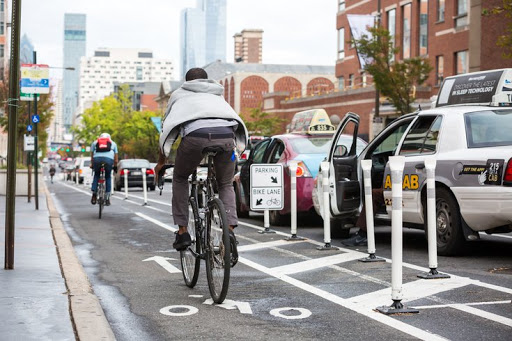
Cycle Smart: 5 Bike and Pedestrian Safety Tips for Everyone
Alexa DeFalco, NC State University field experience student at the Poe Center
With summer in full gear, and people spending more time outside, it is an important time to consider pedestrian and bicycle safety. According to watchformenc.org, more than 3,000 pedestrians and 850 cyclists are hit by vehicles in North Carolina each year. Following these basic few safety rules can help prevent such incidents keep you and your loved ones safe.
Pedestrians: Keep your eye on the cars, and your head out of the stars.
Pedestrians should always walk facing traffic and as far away from the road as possible, even if there is no sidewalk. Before crossing the street at designated crosswalks, pedestrians should look in all directions. As they begin to cross, pedestrians should make eye contact with the drivers to ensure that they see them. Finally, pedestrians should never assume a driver will stop for them and make sure each lane is clear before crossing.
Bikes: Don’t go slow. Go with the flow.

Cyclists, on the other hand, should ride with the flow of traffic. Since bicycles are a vehicle and considered part of traffic, it is important that cyclists use the proper hand signals before making a turn or changing lanes. Signaling occurs using the left arm. It is suggested that cyclists ride in as straight and predictable a line as possible and beware of car doors opening along the side of the street.
Stay bright at night.
When walking or biking at night, it is important to wear bright and reflective clothing to stay visible to cars. Reflective clothing may include safety vests, armbands, or stickers. Pedestrians and cyclists should also carry a flashlight. Walking and biking in well-lit areas under street lights or lamps and avoiding dark unlit areas whenever possible is also important. Finally, stay aware of all surroundings at night. That means limiting distractions, such as texting or talking on the phone and listening to music through headphones.
Use your head. Use a helmet.
Helmets should always be worn when riding a bicycle, and it’s critical to wear them correctly. Just like hats, helmets come in a variety of sizes, need to be fitted, and adjusted each time they are worn. Helmets should sit low on the forehead, about two finger-widths above the eyebrows. The side straps of the helmet should form a V-shape under and slightly in front of the ear. The chin strap should be tightened until snug, and fit so that no more than two fingers can squeeze beneath the strap. Finally, be sure to always replace a helmet after a crash or incident as damage is not always visible.

Beware of danger zones.
There are several high-risk danger zones that people encounter as they walk or bike. These include intersections, driveways, and parking garages. In these situations, it is critical that pedestrians and cyclists are responsible and use all of the senses to watch and listen for cars. When in a parking deck or driveway, pedestrians and cyclists should watch for brake lights, which signal that a car is backing up. They should also be alert as vehicles can be entering or exiting at any time. When planning to cross an intersection, pedestrians and cyclists should cross at designated crosswalks and obey all traffic rules and signs. Remember, always stay focused and defensive.
Walking and cycling are great ways to stay active and healthy. Following these simple safety tips will ensure they are safe forms of activity as well.
 Featured Poe Program: Duke Energy Bike & Pedestrian Safety Kiosk
Featured Poe Program: Duke Energy Bike & Pedestrian Safety Kiosk
Grade Level: Elementary-Middle | Program Length: 10-15 min
Located in the Atrium of the Poe Center, the Safety Kiosk is an interactive exhibit that gives an overview of bike and pedestrian safety. Visitors can click through the interactive touch screen exhibit to learn about hand signals, wearing a helmet, riding safely in traffic, and more.
Come check it out right here at the Poe Center.
Featured Crio Lesson: Bike & Pedestrian Safety
Grade Level: Elementary-Middle | Program Length: 10-15 min

The Poe Center has partnered with SAS through Curriculum Pathways to provide online access to health science and health education lessons at no cost to teachers across the State of North Carolina. Designed to complement its health education curriculum, the Poe Center’s programs and online content are aligned with the North Carolina Department of Public Instruction’s Healthful Living and Science Essential Standards.
This Bike and Pedestrian Safety Crio Lesson focuses on tips and strategies for being safe when biking or walking.
